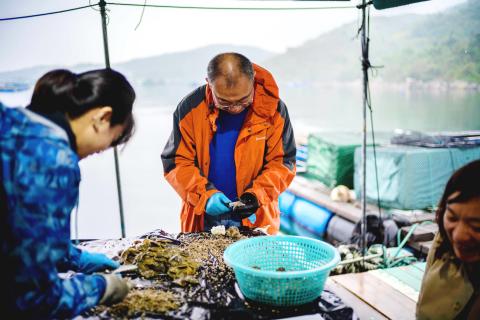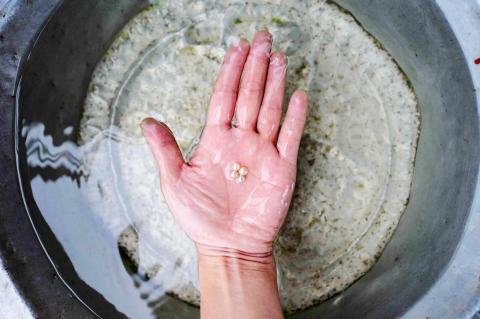On a raft floating off Hong Kong’s rural eastern coastline, former investment banker turned scientist Yan Wa-tat patiently scrapes barnacles off some 2,000 oysters — a tiresome but crucial part of his mission to bring back pearl farming.
“The species was once abundant in Hong Kong,” the 58-year-old lamented. “We have a history of pearl fishing of over 1,000 years... but because of over-fishing in Hong Kong, we only have very few of them left,” he explained.
Yan is farming Akoya pearl oysters, a specimen prized for jewelry, hoping his research will show other fishermen that the industry could be viable.

Photo: AFP
It’s a calling that requires patience. Cultured pearls take around a year to form and every few weeks Yan has to scrape away any barnacles that might compete for food with his precious oysters.
This kind of knowledge was once ubiquitous in the region. After all, the famous waterway that sustains this part of southern China — along one of the world’s most densely populated regions — is called the Pearl River.
The world’s biggest pearl, once owned by Catherine the Great and known as the “Sleeping Lion” because of its bizarre shape, is thought to have been plucked from southern China’s waters sometime in the 1700s before Dutch traders spirited it away.

Photo: AFP
And Hong Kong — dubbed the “Pearl of the Orient” by its former colonial overlords — remains the world’s largest importer and exporter of pearls, with exports topping US$1.8 billion in 2016, according to UN trade data.
But none of them are produced locally. Over-fishing and market forces have long devastated the wild pearl farming trade in the city.
Cultured pearl farming is a relatively modern industry, and a few Hong Kong ventures rose to the challenge in the 1950s. But they struggled against Japanese competitors who came to dominate the trade. The city’s last pearl farm was shuttered in 1981.
OYSTERS AND CHIPS
Now Yan and a handful of fishermen are trying to change that — with a small cottage industry combining traditional knowledge and cutting-edge technology.
Yan worked in Hong Kong’s lucrative banking sector until his mid-50s, when he decided he wanted to do something “more interesting and also more productive for our society.”
He embarked on a doctorate at Hong Kong University’s School of Biological Sciences looking at how to resurrect the city’s pearl farming trade, something he didn’t even know existed until he stumbled across it in early research.
In his lab at Hong Kong University, Yan researches the best ways to insert a radio frequency identification (RFID) chip into an oyster’s nucleus, around which a pearl will then grow — although the exact mechanism is a closely-guarded secret.
The chips are part of the same family of technology that allows users of mobile phones, transport cards and identity badges to scan into a building or to make a purchase with a simple swipe.
Yan holds a scanning device against one of his oysters and after a small bleep sound, a set of numbers appears on an app on his smartphone.
That tech has multiple benefits. Some 10 to 20 percent of nuclei are expelled by the oyster — meaning a cultured pearl is unable to form — but this is usually only discovered when prizing them open at harvest time.
Using a chip means farmers can simply scan the shell to check if a pearl has been produced.
But serial numbers will also allow buyers to know exactly where their pearls have come from, reducing the risk of fakes or lower quality scams.
NEW HARVEST
In March, a group of local fishermen inspired by Yan’s project carried out a harvest of Akoya pearls — the first to be done in Hong Kong in years.
“I think pearl farming has a future in Hong Kong,” explained Leung Kam-ming, one of the owners of a fishing raft culturing Akoya pearl oysters in the rural Sai Kung region. “I started pearl cultivation to make some extra money.”
Leung farms around 30,000 oysters, selling each cultured pearl for around HK$100 (US$12.70). Any pearls that do not meet jewelry standards can be sold along with the oyster shells as pearl powder for Chinese medicine and cosmetics.
While culturing pearls is no longer common knowledge among the Hong Kong fishing community, Leung hopes his successful harvest will set a precedent for other fishermen to follow.
And in a rare development for densely populated Hong Kong, there is plenty of space for new oyster farms.
Yan estimates some 90 percent of the 1,000 or so fishing rafts in the city’s waters are unused because so few young people wish to join the fishing trade these days.
“If I can show to the fishermen that they can make a living, diversify their income sources, then I think they will be interested in doing this,” he predicted.

Exceptions to the rule are sometimes revealing. For a brief few years, there was an emerging ideological split between the Democratic Progressive Party (DPP) and Chinese Nationalist Party (KMT) that appeared to be pushing the DPP in a direction that would be considered more liberal, and the KMT more conservative. In the previous column, “The KMT-DPP’s bureaucrat-led developmental state” (Dec. 11, page 12), we examined how Taiwan’s democratic system developed, and how both the two main parties largely accepted a similar consensus on how Taiwan should be run domestically and did not split along the left-right lines more familiar in

As I finally slid into the warm embrace of the hot, clifftop pool, it was a serene moment of reflection. The sound of the river reflected off the cave walls, the white of our camping lights reflected off the dark, shimmering surface of the water, and I reflected on how fortunate I was to be here. After all, the beautiful walk through narrow canyons that had brought us here had been inaccessible for five years — and will be again soon. The day had started at the Huisun Forest Area (惠蓀林場), at the end of Nantou County Route 80, north and east

Specialty sandwiches loaded with the contents of an entire charcuterie board, overflowing with sauces, creams and all manner of creative add-ons, is perhaps one of the biggest global food trends of this year. From London to New York, lines form down the block for mortadella, burrata, pistachio and more stuffed between slices of fresh sourdough, rye or focaccia. To try the trend in Taipei, Munchies Mafia is for sure the spot — could this be the best sandwich in town? Carlos from Spain and Sergio from Mexico opened this spot just seven months ago. The two met working in the

This month the government ordered a one-year block of Xiaohongshu (小紅書) or Rednote, a Chinese social media platform with more than 3 million users in Taiwan. The government pointed to widespread fraud activity on the platform, along with cybersecurity failures. Officials said that they had reached out to the company and asked it to change. However, they received no response. The pro-China parties, the Chinese Nationalist Party (KMT) and Taiwan People’s Party (TPP), immediately swung into action, denouncing the ban as an attack on free speech. This “free speech” claim was then echoed by the People’s Republic of China (PRC),